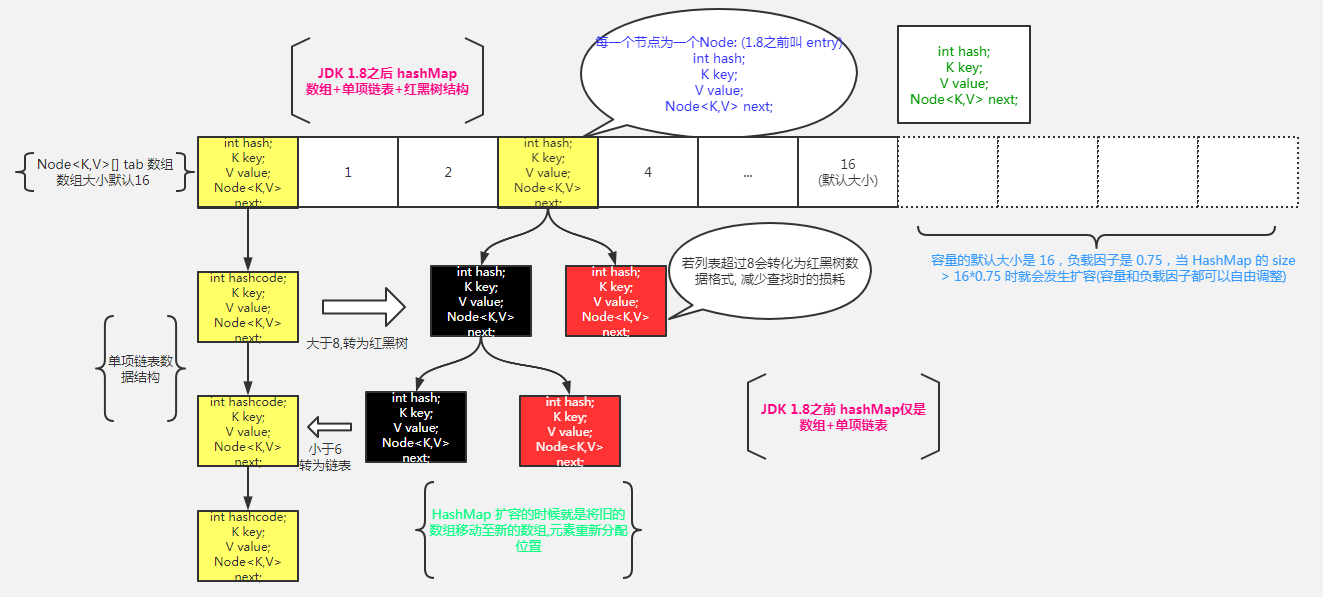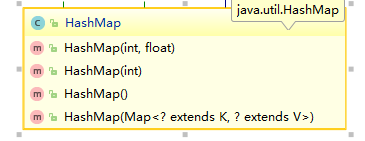1. HashMap继承体系
public class HashMap<K,V> extends AbstractMap<K,V> implements Map<K,V>, Cloneable, Serializable {}
结合下面的类继承关系图,可以看出HashMap的主要作用:
- HashMap<K,V>:HashMap是以key-value形式存储数据的。
- extends AbstractMap<K,V>:继承了AbstractMap,大大减少了实现Map接口时需要的工作量。
- implements Map<K,V>:实现了Map,提供了所有可选的Map操作。
- implements Cloneable:表明其可以调用clone()方法来返回实例的field-for-field拷贝。
- implements Serializable:表明该类是可以序列化的。

2. HashMap的底层数据结构
HashMap的底层结构在JDK1.8 之后确定为数组+链表+红黑树。(1.7是数组+链表,这里不做分析)

通过上面结构图可以看出,其内部存储数据是封装了一种Node的数据结构,通过Node来实现结构名为table的数组。table数组中的每个元素是一个Node元素(这个Node元素可以指向下一个Node元素从而形成链表,当链表长度到达阈值后会升级为红黑树),table数组的每个位置称为桶,比如talbe[0] 称为一个桶。
3. HashMap核心属性
3.1 静态常量
/** * 默认的初始容量,必须是二的次方 */ static final int DEFAULT_INITIAL_CAPACITY = 1 << 4; // aka 16 /** * 最大容量,当通过构造函数隐式指定了一个大于MAXIMUM_CAPACITY的时候使用 */ static final int MAXIMUM_CAPACITY = 1 << 30; /** * 加载因子,当构造函数没有指定加载因子的时候的默认值的时候使用 */ static final float DEFAULT_LOAD_FACTOR = 0.75f; /** * TREEIFY_THRESHOLD为当一个bin从list转化为tree的阈值,当一个bin中元素的总元素最低超过这个值的时候,bin才被转化为tree; * 为了满足转化为简单bin时的要求,TREEIFY_THRESHOLD必须比2大而且比8要小 */ static final int TREEIFY_THRESHOLD = 8; /** * bin反tree化时的最大值,应该比TREEIFY_THRESHOLD要小, * 为了在移除元素的时候能检测到移除动作,UNTREEIFY_THRESHOLD必须至少为6 */ static final int UNTREEIFY_THRESHOLD = 6; /** * 树化的另外一个阈值,table的长度的最小值为64。为了避免扩容和树型结构化阈值之间的冲突,MIN_TREEIFY_CAPACITY 应该最小是 4 * TREEIFY_THRESHOLD */ static final int MIN_TREEIFY_CAPACITY = 64;
3.2 成员变量
/** * table,第一次被使用的时候才进行加载 */ transient Node<K,V>[] table; /** * 键值对缓存,它们的映射关系集合保存在entrySet中。即使Key在外部修改导致hashCode变化,缓存中还可以找到映射关系 */ transient Set<Map.Entry<K,V>> entrySet; /** * table中 key-value 元素的个数 */ transient int size; /** * HashMap在结构上被修改的次数,结构上被修改是指那些改变HashMap中映射的数量或者以其他方式修改其内部结构的次数(例如,rehash)。 * 此字段用于使HashMap集合视图上的迭代器快速失败。 */ transient int modCount; /** * 下一次resize扩容阈值,当前table中的元素超过此值时,触发扩容 * threshold = capacity * load factor */ int threshold; /** * 负载因子 * @serial */ final float loadFactor;
4. HashMap构造方法

实际的构造方法实际上是第一个 java.util.HashMap#HashMap(int, float)。
public HashMap(int initialCapacity, float loadFactor) { //初始容量值校验 范围:0 <= cap <= MAXIMUM_CAPACITY if (initialCapacity < 0) throw new IllegalArgumentException("Illegal initial capacity: " + initialCapacity); if (initialCapacity > MAXIMUM_CAPACITY) initialCapacity = MAXIMUM_CAPACITY; //负载因子值校验 loadFactor > 0 if (loadFactor <= 0 || Float.isNaN(loadFactor)) throw new IllegalArgumentException("Illegal load factor: " + loadFactor); this.loadFactor = loadFactor; //返回一个2的次方数(大于等于当前cap) this.threshold = tableSizeFor(initialCapacity); }
构造方法里值得一提的是 java.util.HashMap#tableSizeFor ,这是一个非常精巧的算法,根据传的cap值大小,返回大于cap且最近的2的整数次幂的数。
/** * Returns a power of two size for the given target capacity. * * 1.返回一个大于等于当前值cap的一个的数字,并且这个数字一定是2的次方数 * 假如cap为10,那么n= 9 = 0b1001 * 0b1001 | 0b0100 = 0b1101 * 0b1101 | 0b0011 = 0b1111 * 0b1111 | 0b0011 = 0b1111 * ...... * ..... * n = 0b1111 = 15 * * 2.这里的cap必须要减1,如果不减,并且如果传入的cap为16,那么算出来的值为32 * * 3.这个方法就是为了把最高位1的后面都变为1 * 0001 1101 1100 -> 0001 1111 1111 -> +1 -> 0010 1111 1111 */ static final int tableSizeFor(int cap) { int n = cap - 1; n |= n >>> 1; n |= n >>> 2; n |= n >>> 4; n |= n >>> 8; n |= n >>> 16; return (n < 0) ? 1 : (n >= MAXIMUM_CAPACITY) ? MAXIMUM_CAPACITY : n + 1; }
5. put方法解析

put方法实际上也是调用的putVal方法,其在调用putVal方法之前有一个 扰动计算hash值 的操作,目的使降低碰撞的概率。
/** * 返回先前key对应的value值(如果value为null,也返回null),如果先前不存在这个key,那么返回的就是null; */ public V put(K key, V value) { return putVal(hash(key), key, value, false, true); } /** * 在往haspmap中插入一个元素的时候,由元素的hashcode经过一个扰动函数之后再与table的长度进行与运算才找到插入位置,下面的这个hash()方法就是所谓的扰动函数 * 作用:让key的hashCode值的高16位参与运算,hash()方法返回的值的低十六位是有hashCode的高低16位共同的特征的 * 举例 * hashCode = 0b 0010 0101 1010 1100 0011 1111 0010 1110 * * 0b 0010 0101 1010 1100 0011 1111 0010 1110 ^ * 0b 0000 0000 0000 0000 0010 0101 1010 1100 * 0b 0010 0101 1010 1100 0001 1010 1000 0010 */ static final int hash(Object key) { int h; return (key == null) ? 0 : (h = key.hashCode()) ^ (h >>> 16); }
putVal方法
final V putVal(int hash, K key, V value, boolean onlyIfAbsent, boolean evict) { //tab:引用当前HashMap的散列表 //p:表示当前散列表的元素 //n:当前散列表数组的长度 //i:表示路由寻址结果 Node<K,V>[] tab; Node<K,V> p; int n, i; //延迟初始化逻辑,第一次调用putVal时会初始化HashMap对象中的最耗费内存的散列表 if ((tab = table) == null || (n = tab.length) == 0) n = (tab = resize()).length; //1. 最简单的情况:寻址找到的桶位 刚好是null,直接将k-v => node 扔进去 if ((p = tab[i = (n - 1) & hash]) == null) tab[i] = newNode(hash, key, value, null); else { //e:不为null的话,找到一个与当前要插入的key-value 一致的key的元素 //k:表示临时的一个key Node<K,V> e; K k; //2. 表示该桶位中的第一个元素与你当前插入的node元素的key一致,表示后序要进行替换操作 if (p.hash == hash && ((k = p.key) == key || (key != null && key.equals(k)))) e = p; //3. 表示当前桶位已经树化了,需要执行放进红黑树的逻辑 else if (p instanceof TreeNode) e = ((TreeNode<K,V>)p).putTreeVal(this, tab, hash, key, value); //4. 当前桶位是一个链表 else { for (int binCount = 0; ; ++binCount) { //4.1 条件成立的话,说明迭代到最后一个元素了,也没有找到一个与你要插入的node一致的元素,即需要放入当前链表的末尾 if ((e = p.next) == null) { p.next = newNode(hash, key, value, null); //新增玩元素后,当前链表长度达到树化标准(8),需要进行树化 if (binCount >= TREEIFY_THRESHOLD - 1) // -1 for 1st //链表转红黑树 treeifyBin(tab, hash); break; } //4.2 条件成立的话,说明找到了相同key的node元素,需要进行替换操作 if (e.hash == hash && ((k = e.key) == key || (key != null && key.equals(k)))) break; p = e; } } //条件成立说明,找到了与要插入的key一致的node元素,进行替换 if (e != null) { // existing mapping for key V oldValue = e.value; if (!onlyIfAbsent || oldValue == null) e.value = value; afterNodeAccess(e); return oldValue; } } //nodeCount表示散列表table结构的修改次数,替换Node元素的value不算 ++modCount; //插入新元素,size自增,如果自增后的值大于阈值,触发扩容 if (++size > threshold) resize(); afterNodeInsertion(evict); return null; }
6. resize方法
在执行put方法时,如果触发扩容,就需要调用resize方法。
final Node<K,V>[] resize() { //region 计算newCap, newThr,为扩容做准备 //oldTab:引用扩容前的哈希表 Node<K,V>[] oldTab = table; //oldCap:扩容之前table数组的长度 int oldCap = (oldTab == null) ? 0 : oldTab.length; //oldThr:扩容之前的扩容阈值,触发本次库容的阈值 int oldThr = threshold; //newCap:扩容之后table数组的大小 //newThr:扩容之后,再次触发扩容的条件 int newCap, newThr = 0; //oldCap > 0 条件成立,说明HashMap中的散列表已经初始化过了(hashmap中的散列表不是null),要进行正常的扩容操作 if (oldCap > 0) { //扩容之前的table数组大小已经达到 最大阈值,则不扩容,且设置扩容条件为int 最大值 if (oldCap >= MAXIMUM_CAPACITY) { threshold = Integer.MAX_VALUE; return oldTab; } //判定条件:oldCap左移一位实现数值翻倍,并赋值给newCap, newCap 小于数组最大值限制 且扩容前的阈值 >= 16 //1. 满足上述条件进行翻倍扩容(假如旧的oldCap为8, < DEFAULT_INITIAL_CAPACITY,那么此条件不成立newThr将不会赋值) else if ((newCap = oldCap << 1) < MAXIMUM_CAPACITY && oldCap >= DEFAULT_INITIAL_CAPACITY) newThr = oldThr << 1; // double threshold } //2. oldCap == 0的情况:说明HashMap中的散列表是null //下面几种情况都会出现oldCap == 0,oldThr > 0 // (1)public HashMap(int initialCapacity); // (2)public HashMap(Map<? extends K, ? extends V> m);并且这个map有数据 // (3)public HashMap(int initialCapacity, float loadFactor); else if (oldThr > 0) // initial capacity was placed in threshold newCap = oldThr; else { // zero initial threshold signifies using defaults newCap = DEFAULT_INITIAL_CAPACITY; newThr = (int)(DEFAULT_LOAD_FACTOR * DEFAULT_INITIAL_CAPACITY); } if (newThr == 0) { float ft = (float)newCap * loadFactor; newThr = (newCap < MAXIMUM_CAPACITY && ft < (float)MAXIMUM_CAPACITY ? (int)ft : Integer.MAX_VALUE); } //endregion threshold = newThr; //创建出一个更长、更大的数组 @SuppressWarnings({"rawtypes","unchecked"}) Node<K,V>[] newTab = (Node<K,V>[])new Node[newCap]; table = newTab; //1. 本次扩容前,table不为null if (oldTab != null) { for (int j = 0; j < oldCap; ++j) { //当前node节点 Node<K,V> e; //当前桶位中有数据,但是数据具体类型还不清楚(单个数据|链表|红黑树) if ((e = oldTab[j]) != null) { //将对应的桶位指向null,方便jvm回收 oldTab[j] = null; //1.1 当前桶位只有一个元素,没有发生过碰撞,此时直接计算当前元素应该存放的位置,设置即可 if (e.next == null) //存放下标计算 : e.hash & (newCap - 1) newTab[e.hash & (newCap - 1)] = e; //1.2 当前桶位为红黑树 else if (e instanceof TreeNode) ((TreeNode<K,V>)e).split(this, newTab, j, oldCap); //1.3 当前桶位为链表 else { // preserve order //低位链表:存放在扩容之后的数组下标位置,与当前数组的下标位置一致 Node<K,V> loHead = null, loTail = null; //高位链表:存放在扩容之后的数组下标位置,为当前数组的下标位置+扩容之前的数组的长度 Node<K,V> hiHead = null, hiTail = null; Node<K,V> next; do { //比如e.hash只能为两种可能 1 1111 或者 0 1111 , oldCap 为 10000 //将原始链表拆为 高位链和低位链 next = e.next; if ((e.hash & oldCap) == 0) { if (loTail == null) loHead = e; else loTail.next = e; loTail = e; } else { if (hiTail == null) hiHead = e; else hiTail.next = e; hiTail = e; } } while ((e = next) != null); //1.3.1 低位链表有数据 if (loTail != null) { loTail.next = null; newTab[j] = loHead; } //1.3.2 高位链表有数据 if (hiTail != null) { hiTail.next = null; newTab[j + oldCap] = hiHead; } } } } } return newTab; }
扩容resize算是HashMap中最核心的操作了,下面是其执行的流程:

结合例子:当在table长度位16中的元素移到table长度位32的table中的时候,我们可以知道,原来在15这个槽位的元素的hash()值的后四位一定是1111(因为跟1111即table长度-1 进行与运算得到了1111)。所以所以当table长度变为32的时候,原来在15这个槽位的元素要么还在15这个槽位,要么在31这个槽位(因为原来15这个槽位的元素后五位一定是11111或者01111,跟 11111即table新长度-1 进行与运算一定得到 01111或者11111)。
7. remove方法

remove方法也是调用的removeNode方法。
public V remove(Object key) { Node<K,V> e; return (e = removeNode(hash(key), key, null, false, true)) == null ? null : e.value; } /** * Implements Map.remove and related methods * * @param hash hash for key * @param key the key * @param value the value to match if matchValue, else ignored * @param matchValue if true only remove if value is equal * @param movable if false do not move other nodes while removing * @return the node, or null if none */ final Node<K,V> removeNode(int hash, Object key, Object value, boolean matchValue, boolean movable) { // tab:引用当前hashmap的table // p:当前的node元素 // n:当前的散列表数组长度 // index:表示寻址结果 Node<K,V>[] tab; Node<K,V> p; int n, index; //1. 如果数组table为空或key映射到的桶为空,返回null if ((tab = table) != null && (n = tab.length) > 0 && (p = tab[index = (n - 1) & hash]) != null) { // node:查找到的结果 // e:当前Node的下一个元素 Node<K,V> node = null, e; K k; V v; //2. 桶位的头元素就是我们要找的 if (p.hash == hash && ((k = p.key) == key || (key != null && key.equals(k)))) node = p; //当前桶位要么是数组,要么是红黑树 else if ((e = p.next) != null) { //3. 当前桶位已形成红黑树 if (p instanceof TreeNode) node = ((TreeNode<K,V>)p).getTreeNode(hash, key); //4. 当前桶位已形成链表 else { do { if (e.hash == hash && ((k = e.key) == key || (key != null && key.equals(k)))) { node = e; break; } p = e; } while ((e = e.next) != null); } } //如果node不为null,说明按照key查找到想要删除的数据了 if (node != null && (!matchValue || (v = node.value) == value || (value != null && value.equals(v)))) { //上面3.的情况,node是树节点,执行树节点移除操作 if (node instanceof TreeNode) ((TreeNode<K,V>)node).removeTreeNode(this, tab, movable); //上面2.的情况,桶位元素执行删除 else if (node == p) tab[index] = node.next; //上面4.的情况,将当前元素p的下一元素 设置为 要删除元素的下一元素 else p.next = node.next; ++modCount; --size; afterNodeRemoval(node); return node; } } return null; }
8. get方法

get方法也是调用getNode方法,调用前有hash计算操作。
public V get(Object key) { Node<K,V> e; return (e = getNode(hash(key), key)) == null ? null : e.value; } /** * Implements Map.get and related methods * * @param hash hash for key * @param key the key * @return the node, or null if none */ final Node<K,V> getNode(int hash, Object key) { // tab:引用当前hashmap的table // first:桶位中的头元素 // n:table的长度 // e:是临时Node元素 // k:是key的临时变量 Node<K,V>[] tab; Node<K,V> first, e; int n; K k; //如果哈希表为空,或key对应的桶为空,返回null if ((tab = table) != null && (n = tab.length) > 0 && (first = tab[(n - 1) & hash]) != null) { //1. 定位出来的桶位头元素即为要找的数据 if (first.hash == hash && // always check first node ((k = first.key) == key || (key != null && key.equals(k)))) return first; //2. 当前桶位不止一个元素,其结构可能为 链表|红黑树 if ((e = first.next) != null) { // 2.1 桶位已形成红黑树 if (first instanceof TreeNode) return ((TreeNode<K,V>)first).getTreeNode(hash, key); //2.2 桶位已形成链表 do { if (e.hash == hash && ((k = e.key) == key || (key != null && key.equals(k)))) return e; } while ((e = e.next) != null); } } return null; }